Seagate's New Barracuda 3TB (ST3000DM001) Review
by Anand Lal Shimpi on November 2, 2011 11:00 PM ESTPlatter density has been the crutch of hard drive makers in recent history. Increasing spindle speeds can reduce random access latency, but at the expense of cost and thermals. Improvements in random access performance via increasing spindle speed pale in comparison to what is possible with solid state storage, not to mention that driving motors at speeds beyond 10,000 RPM becomes quite difficult. The focus on increasing platter density is also difficult, but higher density platters can actually lead to reductions in power consumption rather than the opposite (through a reduction in the number of platters per drive). There's also the fact that if you can cram more data on a single platter there's a direct impact on sequential accesses.
Yesterday Seagate announced its transition to 1TB platters with its new 7200RPM-only Barracuda line. The move marked a significant change for Seagate as it is phasing out the Barracuda Green brand, and shifting the focus of the high-performance Barracuda XT. The Barracuda Green was a rebrand of Seagate's Barracuda LP, designed to convey the lower power consumption enabled by its 5900RPM spindle speed.
Seagate decided that the performance loss of moving to 5900RPM wasn't justified by the power savings. It believed that by introducing a more power efficient 7200RPM drive it could deliver the best of both worlds, negating the purpose of the Green line. For most desktops, Seagate has a point. The couple of watts you save by slowing down the motor aren't really realized in a system that idles at 60W and can consume over 100W under load. On the other hand, the performance drop is definitely noticeable. Hard drives have pretty bad random access performance to begin with, and slowing spindle speed isn't going to help:
| Impact of Rotational Speed on Random Access Performance - Barracuda vs Green | ||||
| 7200RPM | 5900RPM | |||
| 4KB Random Write Performance (8GB LBA) | 1.20 MB/s | 0.90 MB/s | ||
Random write performance goes up by almost 20% when you compare the Barracuda XT to the Barracuda Green. Performance in this test is mostly governed by spindle speed (and firmware), so it makes Seagate's case perfectly.
There is a segment that Seagate isn't considering as it decides to axe the Green line: the home server market. If you're doing mass archival to some external storage, random performance is likely not a big concern. Instead, all you want is cheap, low-power storage.
Come February 2012, if you want a Green drive, you'll have to shop with Western Digital.
At the other end of the spectrum, the Barracuda XT has been Seagate's performance flagship. This brand isn't going away. Instead Seagate will introduce a solid state hybrid drive under the Barracuda XT banner at some point in the future.
Everything else now falls under the bare Barracuda label. High capacity drives should become more power efficient thanks to a reduction in the number of platters, and performance should go up thanks to increased platter density.
The new 1TB platter drives all carry the M001 suffix to their model numbers:
| Seagate's 1TB-per-platter Barracuda Lineup | ||||
| Model Number | Capacity | MSRP | ||
| ST3000DM001 | 3TB | $179.99 | ||
| ST2000DM001 | 2TB | $105.99 | ||
| ST1500DM001 | 1.5TB | $83.99 | ||
| ST1000DM003 | 1TB | $71.99 | ||
Seagate sent along a new 3TB Barracuda for us to put through the paces.
The Performance
With lower power consumption in mind, Seagate is now using a 40nm dual-core LSI controller on the 1TB-platter Barracudas. The chip is physically a lot smaller than what was used in the original 3TB Barracuda XT:
Seagate continues to use 64MB of DDR2-800 as the Barracuda's DRAM cache.
The big news is obviously the platter count with the new 3TB Barracuda. While the previous drive used five platters, the new 3TB drive only uses three. It's this reduction that Seagate hopes will give it the performance and power advantages necessary to not only move the family forward, but render the outgoing Green redundant.
To find out, we threw some of our storage suite at the drive and compared it to the old Barracuda XT and Green drives. I also ripped the drive out of Seagate's 4TB GoFlex Desk enclosure, a 5-platter Barracuda XT, and included it in the comparisons.
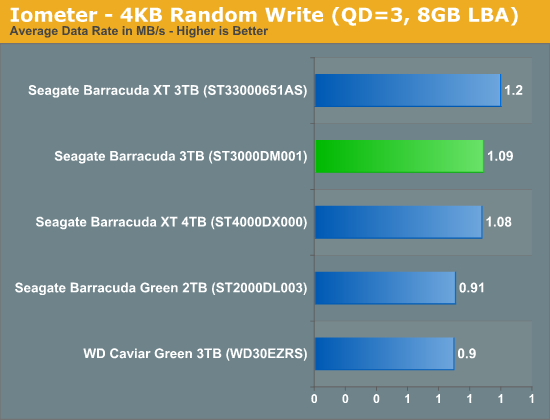
Random write performance actually dropped a bit compared to the older Barracuda XT. It's still higher than the Green drive, but it looks like Seagate has tweaked the drive's firmware a bit resulting in lower random write performance.

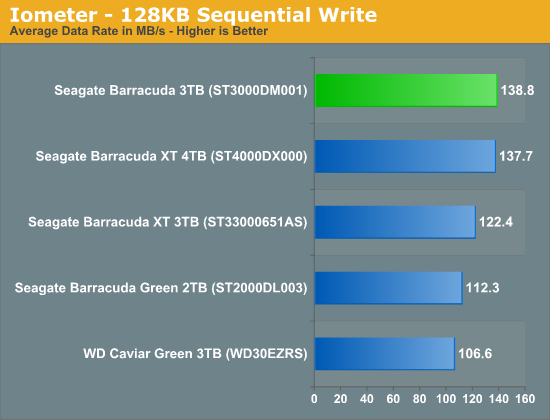
Sequential performance is up a bit over the original 3TB Barracuda XT, but about in-line with what we'd expect from a modern day high-capacity drive. Even compared to the latest 4TB Barracuda XT, we see a slight increase in performance.
Despite the sequential performance advantage, PCMark 7 showed the new Barracuda on-par with the Barracuda XT:
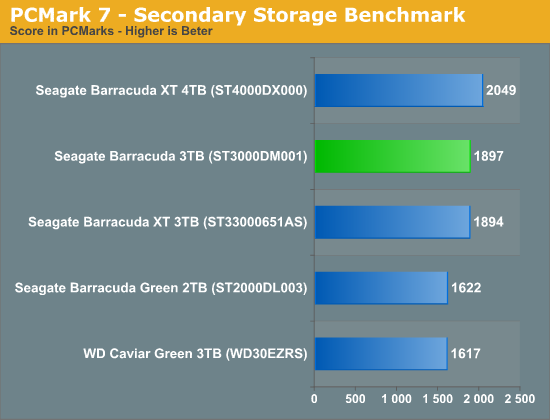
I ran the drives through our light and heavy 2011 workloads from our SSD reviews (which takes absolutely forever to run on mechanical drives) and saw some interesting data:
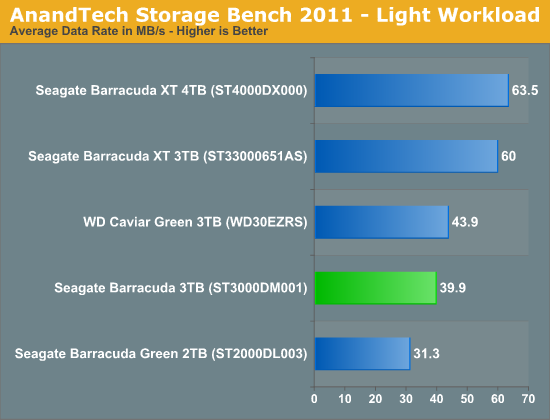

The Barracuda XT was consistently faster than the new 3TB Barracuda in our trace based benchmarks. Keep in mind that both of these tests were created on and for SSDs. Both tests involve a much heavier usage pattern and demand ultra quick response time, likely giving these hard drives an extremely strenuous workout. While the new Barracuda is faster than the outgoing Green, it seems as if the firmware isn't quite as tuned for performance as the XT. The difference does make sense, particularly if it translates into lower power usage given the new mainstream focused Barracuda lineup.
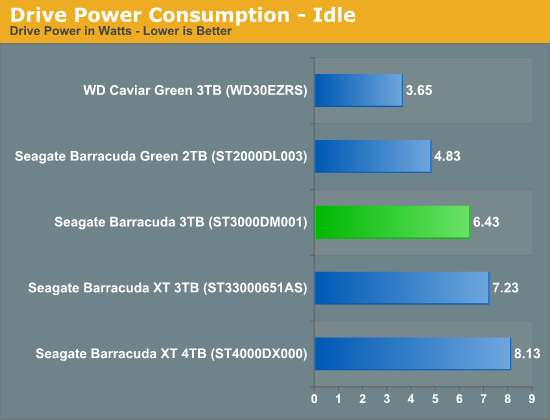
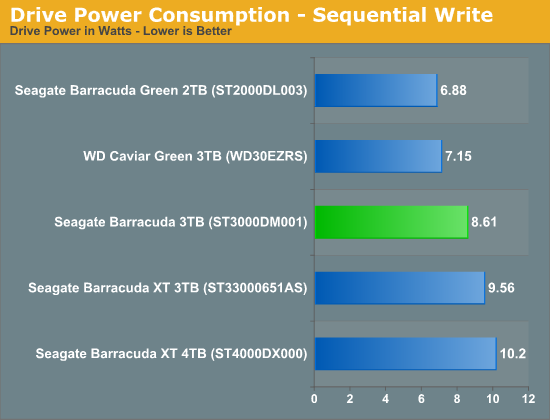
Power consumption is obviously lower than the old Barracuda XT, but still not quite as low as a 5400RPM Barracuda Green or WD Caviar Green. If you were expecting the new Barracuda to completely replace the outgoing Barracuda Green you will be disappointed. It looks like if you need a high capacity, low power 3.5" drive going forward it won't be from Seagate.
Final Words
The new 3TB Barracuda is a bit faster in sequential performance than the old Barracuda XT, at lower power consumption. In typical desktop workloads I think it's fairly safe to say that you wouldn't notice the difference between the Barracuda and Barracuda XT.
As our SSD tests showed us however, when really pushed the new Barracuda performs somewhere in between the old Green and the XT. Seagate appears to have optimized the drive's behavior for lower power rather than peak performance. If you want the absolute best performance out of a 3.5" drive, stick with the XT or wait for the new hybrid version.
Given the tremendous advantage SSDs offer over even the fastest 3.5" drives, I'm personally ok with the performance tradeoff under very heavy load so long as you've got an SSD somewhere in your system as well. I'm not sure I particularly agree with Seagate's decision to abandon the 5900RPM drive market, but thankfully there are other options available if you want a high capacity, lower power drive.




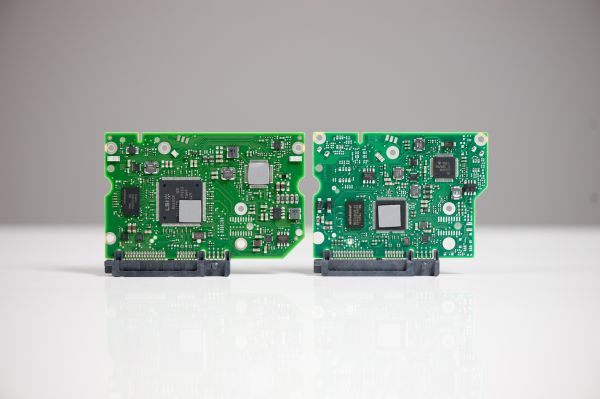
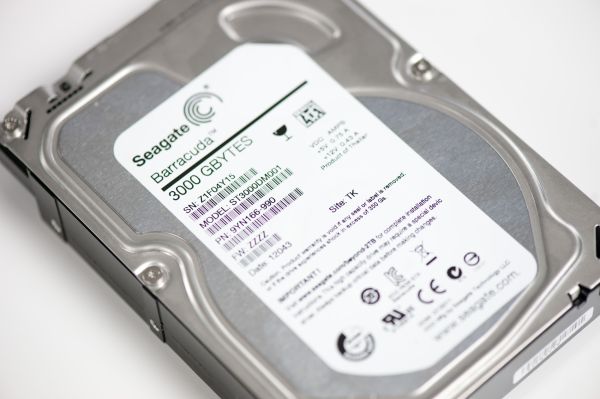








77 Comments
View All Comments
sduguid - Tuesday, November 8, 2011 - link
There's really not much point in going back and forth on this any further. I have a large number of drives in active service and I do not see the issues you are referring to.The 7200.11 family was largely skipped over and I am perfectly willing to agree that it may have been problematic. As I said earlier, there is likely a reason they replaced that family so quickly. I used few of them. 7200.12 I have found to be rock solid.
Everyone has their preferences and we're not going to convince each other to change so I think we can agree to disagree.
By the way, it is possible that I will start to see abnormal issues or failures with the 7200.12 series but I'm simply saying that I have not to this point.
JHBoricua - Thursday, November 10, 2011 - link
You can buy the 2TB drive for a cool $289.00http://www.newegg.com/Product/Product.aspx?Item=N8...
mikbe - Sunday, May 20, 2012 - link
I wonder if the target audience is people that use an SSD as their primary drive but want a moderately fast second data drive. Something they can use for: storing infrequently used files, a scratch disk, Internet browser temp files, Microsoft's virtual memory, and other activities that write a lot of tiny temporary files that will decrease the life of an SSD.They want a middle of the road drive that will be reliable and fast but they don't need a 10,000RPM drive that will die in a year and uses as much energy as a small hamlet or a 5,400RPM Eco drive that takes forever to transfer data back and forth.
UltraTech79 - Sunday, April 21, 2013 - link
Hmm no dB measurements? C'mon..n13L5 - Saturday, June 29, 2013 - link
One would really wish Anandtech and everybody else would vastly reduce the role of speed benchmarks in their tests for hard drives...Instead, give some room to figure out likely reliability and at least quote MTBF, if its rated for 24/7 operation or 8 hours/5days a week etc...
Reliability, heat and noise far outweigh any speed considerations since we have SSDs.
Its a huge drag to slog through review after review, being presented with the same benchmark charts that are very close to irrelevant now. They should at most occupy 1/4 of a review.
oranos - Wednesday, May 14, 2014 - link
This + SSD OS with cache partition for Intel Rapid Storage Technology is the ideal setup for any home user.Alientech - Thursday, May 28, 2015 - link
I got an email from Seagate if I would partake in their questionare and would be willing to do reviews for samples and the last question was would I recommend their products to others. After having been strongly attacked when I was trying to find out more information on some of their drives, I believe people think if they come out strongly against those who comment negatively then companies will consider them for review units. I just dont see the point otherwise for such strong opinions from people who have no experience. If anything a company like blackbaze can be trusted to more accurately show their experiences especially when it matches your own. Using thousands of drives and not having more a couple of failures defies even the marketing that the companies put out and they should take photos of such people and post it with their recommendations because of such good luck in getting all the high quality drives. Its like getting 5GHZ intel cpu's without having to buy millions like some companies do to actually get a couple of them they can show off with.I also wonder about some of the tests. My crucial 240GB M500 SSD showed a far different picture than what I seen in review sites and I could not figure it out for an year. Where ever there was data on the drive it would show read speeds of 250MB, the blank areas would show 500MB read speeds.. On just one site I saw a similar snapshot explaining that it was the address translations slowing down the drive when reading from the used data area. So how come other sites say they were benching dirty drives but it not showing the same problems? The same way, when I benched this ST3000DM001 I saw very different results. It was like they were using zones of SMR to fit more data and seagate itself would provide no information on it. The 8 or so zones on the drive showed the data read speeds slowing down and then picking up again, which I never seen on any other drive. It could be seagate was testing new ways to pack in more data and also have SMR type tracks work for efficiently. I have not had experience with thousands of drives, but I do have experience with hundreds of drives. Seagate is a marketing company, nt a technological powerhouse, they sell cheaply made low quality drives for far less than others. Put other companies out of business and buy them out and use their patent portfolio to survive. CDC drives were more than twice as fast as seagate drives of the time. Once seagate got their hands of them, CDC drives were not reliable. Same goes with Quantum. My friend was always so proud of how fast their drives were and would boast of their reliability, of course they dropped off a cliff once Seagate got them. Maxtor drives were not reliable but they were fast. A match made in heaven. But at least maxtor had 5 years warranty and usually failed only in the 6th year. The dozen or so progressive drive all failed in a staggered fashion after the warranty expired for all the weird reasons.
But I did find a couple of messages even on seagate forums that they were experiencing the very same results and problems I had with drives using a particular firmware. Seagate not answering speaks loudly about why that would be. and the ever decreasing warranty periods and things like 5 days of 8 hour usage and other stipulations on how to void the warranty. It is like some SSD makers slowing down their drives after hard usage so it lasts the 10 years of warranty.